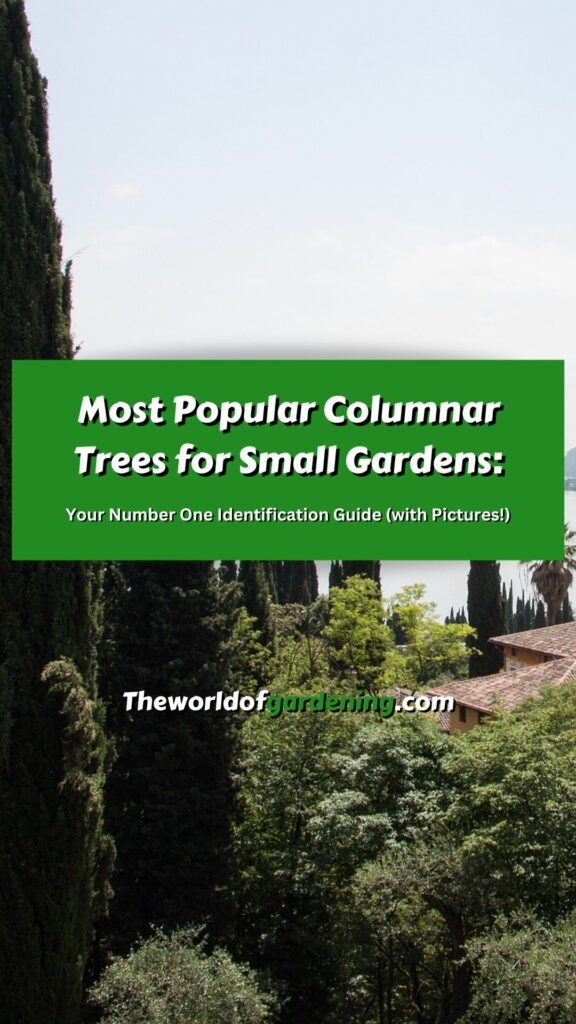Columnar trees are the ideal option for gardening in small spaces because they provide impact even in small areas. Slim evergreen and deciduous trees designed for small spaces can serve as the focal point of your garden, making an attractive design, or highlight an aspect of your property. Perfect for small spaces, thin columnar trees are vital for gardening in small spaces when you are looking to construct an organic privacy fence. Conical trees that have narrow widths are great to grow in containers.
Of course, small columnar trees can be used for landscaping benefits in every garden. In urban areas, where green spaces surrounding houses are scarce, slim columnar trees can serve important landscaping benefits. Planting small trees will ensure that they don’t outgrow your small garden.
What are the top columnar trees for small gardens? This article examines trees with slim girths that make them ideal for landscaping small spaces.
Columnar Trees for Small Gardens
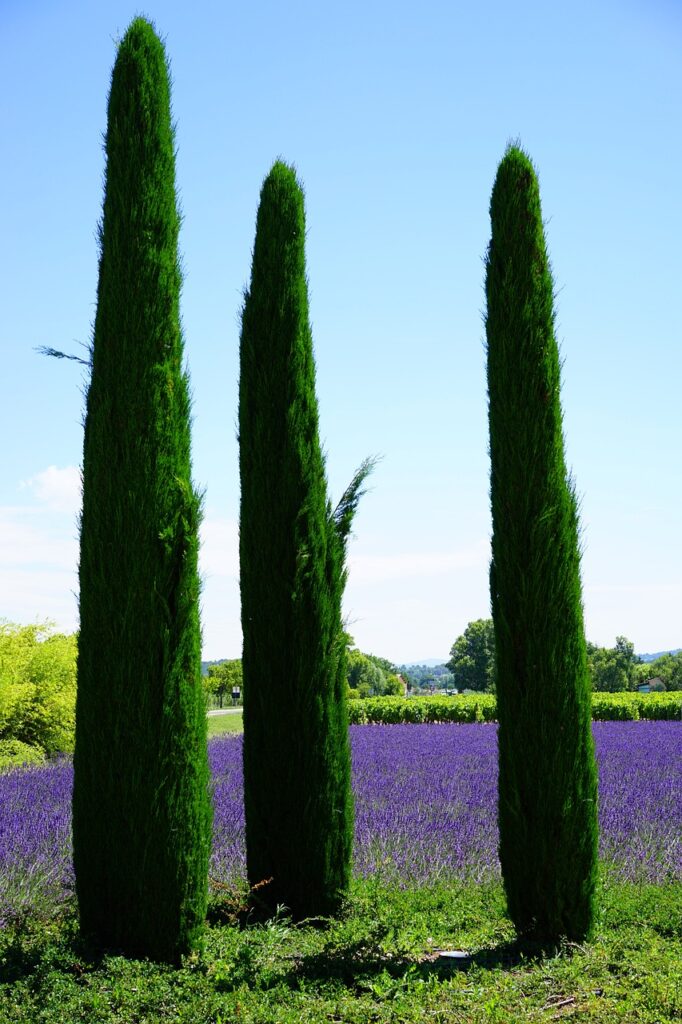
Image by and Credit to: Hans
Columnar trees are great for small gardens because of their slim, narrow shape. While the majority of columnars are evergreens, there are many thin deciduous trees that are ideal for planting in small spaces.
To increase a landscape’s appearance, select narrow trees that have the appearance of weeping or drooping branches. Trees with smaller forms provide shade beauty, as well as protection from brutal winter winds in areas in which space is scarce.
What Are the Advantages of Having Columnar Trees for Small Gardens?
The slim, narrow upright columnar trees are ideal to plant in small landscapes. Their slim growth patterns make them slim and don’t need a lot of space. In the case of a limited space in a small space The slim trees due to their small footprints provide vertical beauty without encroaching onto the horizontal space.
Another advantage of planting spike-like or pencil-like trees is that they reduce maintenance. A lot of columnar cultivars and hybrids retain their upright, conical form without much pruning. If you plant evergreen columnar trees, you can remove garden chores during the fall.
Different Types of Evergreen Columnar Trees for Small Gardens (with Pictures!)
Even if you’ve got the tiniest of gardens There are many evergreen columns that will meet your needs for landscaping. Read on to discover the most beautiful evergreens with conical and narrow shapes and foliage that stays all through the entire year.
Dragon Lady Holly (Ilex x Aquipernyi ‘Meschick’)
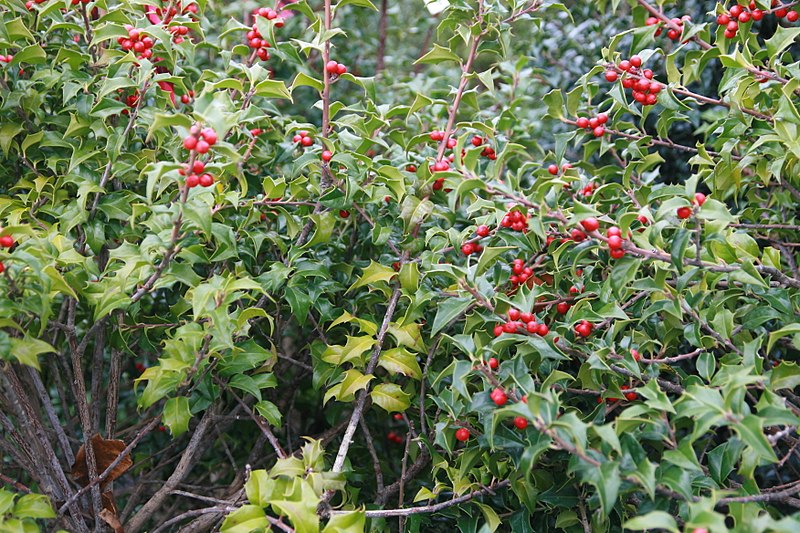
Image by and Credit to: David J. Stang
“Dragon Lady” holly trees are great trees that are narrow for privacy as well as for border trees
The holly cultivar Meschick, also known as Dragon Lady Holly, is small evergreen tree that has an impressive pyramidal crown. The characteristics of the holly tree include lush green, spiky foliage, tiny, unnoticeable white flowers, and vibrant red berries. The sharp leaves and the densely expanding foliage makes this compact columnar tree perfect for a privacy hedge, impenetrable hedge or foundation planting to provide security.
With its compact, upswinging growth this dragon lady’s holly is 20 feet (6 meters) tall and up to 6 feet (1.2 up to 1.8 meters) in width. Because of its columnar shape it is able to fit in tight spaces. Furthermore, the glossy green leaves and vibrant red berries bring winter color.
- USDA Zones: 6 to 8
- Soil: Well-drained, moist soil
- Light Exposure: Sun to Shade
- Size: 20 feet (6 meters) tall, 4 to 6 feet (1.2 – 1.8 meters) spread
Japanese Plum Yew ‘Fastigiata’ (Cephalotaxus harringtonia ‘Fastigiata’)
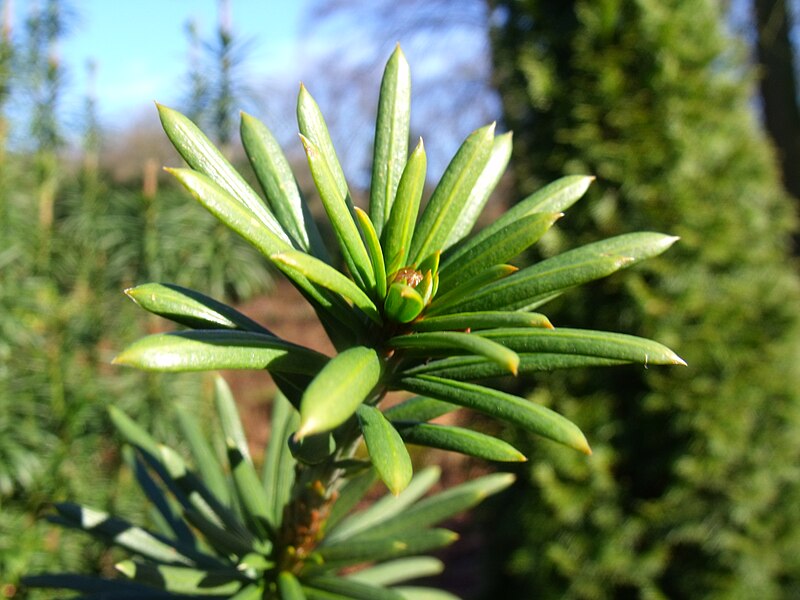
Image by and Credit to: Alice Chodura
It is the Japanese plum yew “Fastigiata” is a columnar-growing tree that is a dwarf evergreen tree
Even if you’re planning to plant the smallest of gardens there are appropriate dwarf columnar trees such as those that are miniature, like the Japanese yew , ‘Fastigiata. This miniature tree features long needle leaves with dark, dark shades that grow circularly around stems that are growing upwards with a narrow vertical growth pattern, and is tolerant of shade and heat. The small size of the tree is a perfect fit to plant in pots.
A tall Japanese plum yew can grow to 5 feet (1.5 meters) tall and is 3 feet (1 m) across. The compact nature of its growth makes it an extremely versatile landscaping plant suitable for small areas. It is a great choice for an attractive plant for foundations or a specimen plant or as an organic border when it is planted in groups.
- USDA Zones: 5 to 9
- Soil: It is a sandy, well-drained soil
- Light Exposure: From full sun until complete shade
- Size: 5 ft. (1.5 m) tall, 3 ft. (1 m) spread
Tall Columnar Evergreen Eastern Red Cedar “Taylor” (Juniperus virginiana “Taylor”)
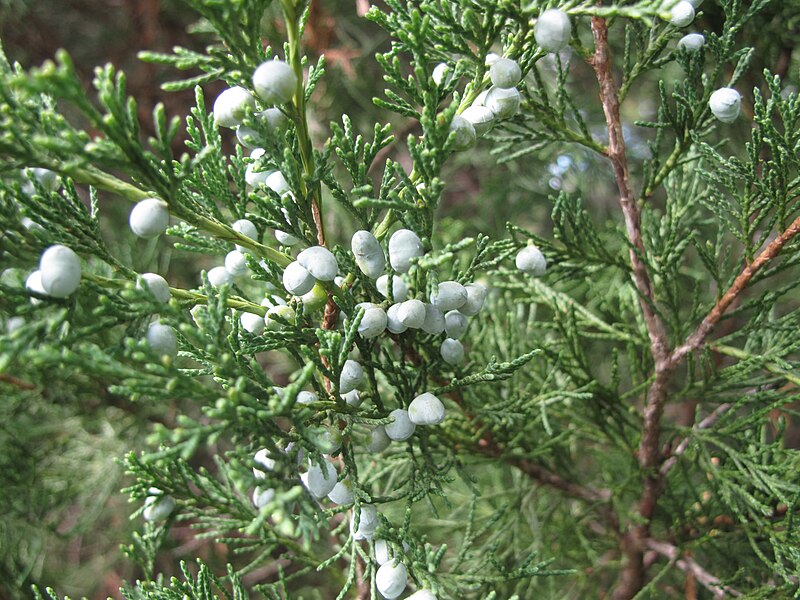
Image by and Credit to: Ayotte, Gilles
“Taylor” red cedar is an evergreen that is slender and does not take up a lot of area.
The thin eastern red cedar cultivar ‘Taylor’ features the distinctive pencil shape making it a good choice for growing in small spaces. It’s a tall and narrow columnar landscape tree that has semi-soft, emerald green foliage. The leaves change to a distinct bronze hue in the winter. The tree’s thin form gradually tapers until it reaches a point near the top. It is suitable to USDA zones 4 to 9.
The eastern red cedar is 10 times taller than its width. The moderately fast-growing trees eventually reach 15 to 20 feet (4.5 to 6 meters) tall, yet it doesn’t get more than 4 feet (1.2 meters). If planted in a mass this columnar tree is great for privacy screens or borders for windbreaks. It’s also a wonderful front-of-house tree that can be used as an accent vertically.
- USDA Zones: 4 to 9
- Soil: Well-drained soil
- Light Exposure: Full sun
- Size: 15 to 20 feet (4.5 to 6 meters) tall 3 to 4 feet (0.9 between 0.9 and 1.2 1 m) spread
Columnar Evergreen White Spruce Tree (Picea glauca “Pendula”)
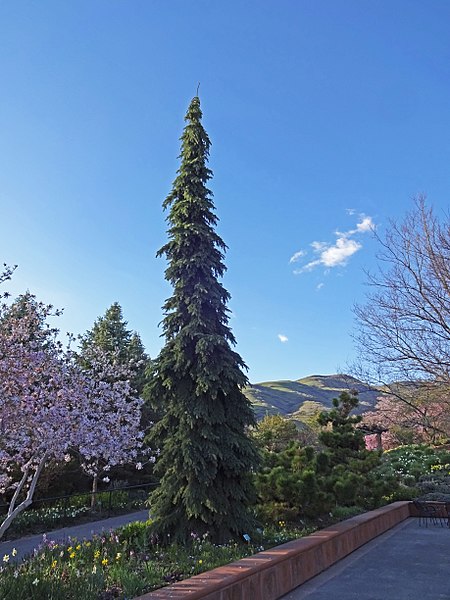
Image by and Credit to: Andrey Zharkikh
The slim columnar white spruce with its emerald-like nature is great to plant in small spaces.
The cultivar of white spruce “Pendula” is a graceful columnar tree that is slender and slender. It is distinguished by branches falling down the trunk. The slim evergreen tree features needle-like leaves that are dark green and cover the stems which fall almost vertically. The rapidly growing columnar conifer is ideal for creating an accent vertically within a tiny garden.
The white spruce weeping ‘Pendula’ can grow from 12 to 40 feet (3.6 – 12 meters) high and 5 feet (1.5 meters) in width. The graceful landscape tree is thriving within USDA zones 2 to 6. Though it is a fan of cooler climates, it is possible to plant it in warmer areas in the event that it has enough air circulation.
- USDA Zones: 2 to 6
- Soil: Well-drained soil
- Light Exposure: Full sun
- Size: 12 to 40 feet (3.6 to 12 meters) high, 5 feet (1.5 m) spread
Columnar Sky Pencil Holly (Ilex crenata “Sky Pencil’)
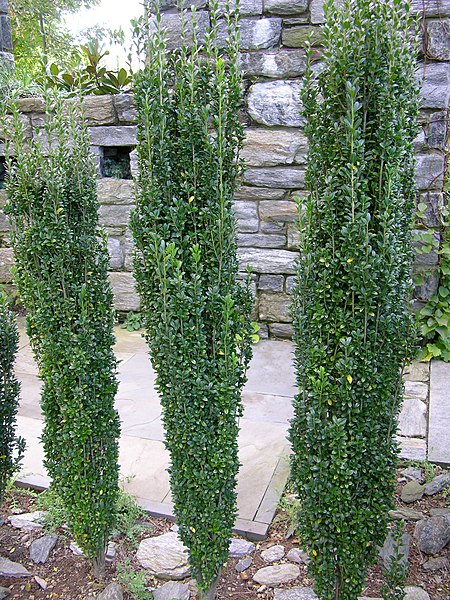
Image by and Credit to: Ram-Man
“Sky Pencil” holly has a slender growth habit and is a fantastic option for small-sized gardens.
Sky pencil holly is an evergreen columnar plant that is perfect for small spaces due to its upright growth pattern and compact dimensions. The slim holly tree features upward-growing branches that are covered with tiny glossy green leaves. In the summer months it also has tiny white flowers. The small columnar tree is perfect for planting in small spaces to create a focal point vertically.
Perfect for growing in USDA zones 6-8 The evergreen sky pencil holly can grow up to 6-10 feet (1.8 to 3 m) tall and is less than 3 feet (1 m) in width. Because of its small size this pencil-like tree is a great choice for an evergreen hedge with a thin appearance as a container plant or you can cut it back to plant along the foundation line.
- USDA Zones: 6 to 8
- Soil: A little acidic, well-drained soil that is moist and well-drained.
- Light Exposure: Full sun
- Size: 6 to 10 feet (1.8 – 3 meters) tall, 1 to 3 feet (0.3 up to 0.9 meters) spread
“North Pole” Arborvitae (Thuja occidentalis “North Pole”)
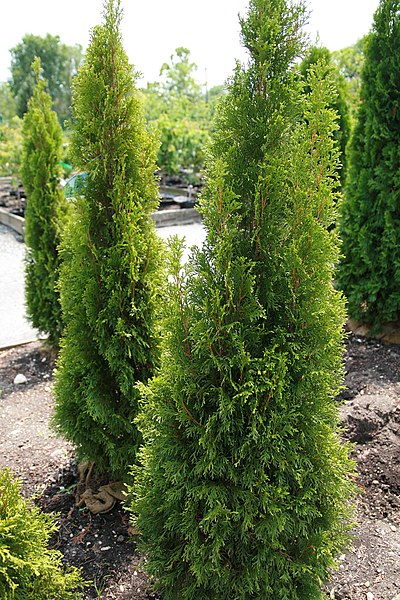
Image by and Credit to: David J. Stang
The ornamental, narrow ‘North Pole arborvitae’ is also known as “Art Boe” Thuja
The cultivar of the arborvitae called “North Pole” is a columnar tree that has the shape of a conical, making it ideal for small gardens. The arborvitae plant, with its slim shape and soft, feathery leaves makes it ideal for small gardens to landscape. Additionally, it’s an ideal tree that is slim for making an ornamental hedge, natural screening as a foundation plant or specimen tree. It’s also a great plant to grow in pots.
The ‘North Pole’ tree is 4 to 6 feet (1.2 up to 1.8 meters) tall. Its size is 5 feet (1.5 meters) in width at its base, the tree is suitable for small gardens. In addition to planting it in the ground, you can plant the conifer in a pot for a greener entranceway.
Ideal for planting in USDA zones 3 to 7.
- USDA Zones: 3 to 7
- Soil: Well-drained, moist soil
- Light Exposure: Full sun
- Size: 4 to 6 feet (1.2 up to 1.8 meters) high,5 feet (1.5 m) spread
Evergreen American Arborvitae “Yellow Ribbon’ (Thuja occidentalis ‘Yellow Ribbon’)
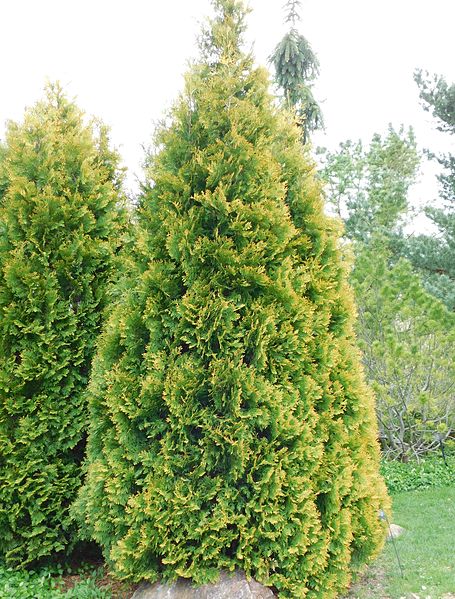
Image by and Credit to: Ruff tuff cream puff
The beautiful “Yellow Ribbon” Arborvitae has an elongated pyramidal form and is a wonderful choice for tight spaces.
The “Yellow Ribbon” American arborvitae is a cone-shaped conifer that has a slim footprint. It is ideal for even the tiniest of gardens. The evergreen columnar plant features beautiful yellowish-green leaves. The smooth, flattened, scale-like leaves abound on the upward branches, creating an appearance of a column.
The arborvitae “Yellow Ribbon” is a narrow and tall evergreen tree. It can grow in a range of 8-10 feet (2.4 to 3 meters) tall, and is only about 3 feet (0.9 meters) across. Landscape ideas for this columnar, conical tree include using it for an privacy screen, an accent vertically, or on the corners of a home.
Planting is suitable for USDA zones 2 to 7.
- USDA Zones: 2 to 7
- Soil: is well-drained soil
- Light Exposure: Part sun to full shade
- Size: 8-10 feet (2.4 -3 meters) high, 3 feet (0.9 3 m) spread
Evergreen Colorado Blue Spruce ‘Fastigiata’ (Picea pungens ‘Fastigiata’)
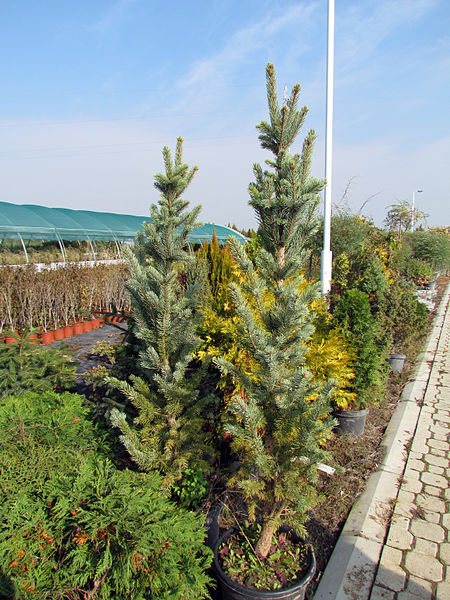
Image by and Credit to: Gmihail
The cone-shaped Colorado blue spruce an extremely cold-hardy evergreen ornamental tree suitable for landscapes with small spaces
It is the Colorado blue spruce , ‘Fastigiata’ is a slender columnar tree, which is suitable for small gardens as well as small space. The characteristics characteristic of cone-shaped Colorado blue spruce are bluish-green needle-like, leafy shape and an elegant form. This evergreen conifer cultivar, ‘Fastigiata’ is the tiniest of blue spruce species.
The Fastigiata Colorado blue spruce is ideal in a small garden. The conifer’s slow growth is 20 feet (6 meters) tall, but just 4 feet (1.2 meters). The spruce, however, will take 10 decades to attain its maximum size.
It is possible to grow this tree as a columnar in your small area within USDA zones 2 to 7.
- USDA Zones: 2 to 7
- Soil: A little acidic, well-drained soil
- Light Exposure: Full sun
- Size: 20 ft. (6 m) tall, 4 ft. (1.2 m) spread
A narrow Skyrocket Juniper (Juniperus virginiana “Skyrocket”)
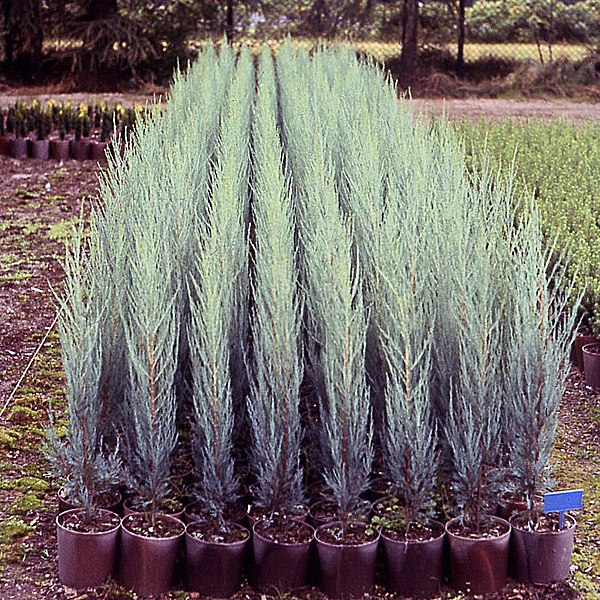
Image by and Credit to: Gmihail
The skyrocket juniper can be described as one of the most narrow types of juniper, and it is a columnar, slender form. The evergreen, narrow tree has blue-green leaves, blue berries in the winter months, and sharply-pointed leaves. Skyrocket Junipers are able to fit into small places in small gardens. They can be grown in tight spaces between homes.
Skyrocket juniper conifers are 25 and 35 feet (7.6 to 10.6 meters) tall and just 6 to 8 feet (1.8 up to 2.4 meters) across. The shape of the rocket makes it an ideal columnar plant to add visual interest in any garden that has limited space. Skyrocket is a Juniper tree in USDA zones 3-9.
- USDA Zones: 3 to 9
- Soil: Well-drained soil
- Light Exposure: Full sun to part shade
- Size: 25 to 35 feet (7.6 m – 10.6 meters) tall, 6-8 feet (1.8 – 2.4 meters) spread
Moonglow Juniper (Juniperus scopulorum “Moonglow”)
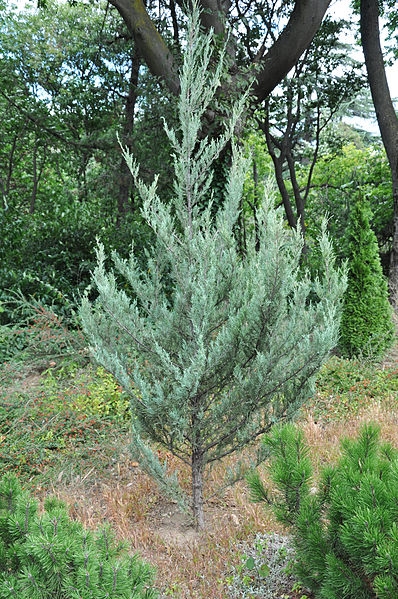
Image by and Credit to: Lazaregagnidze
Moonglow juniper is a beautiful evergreen tree, with a narrow shape and silvery green leaves
Moonglow juniper trees are an evergreen conifer in columnar shape with an elongated shape. It is distinguished by its stunning silver foliage as well as its conical form. This makes it an attractive landscaping option for small front or backyards. Like the name implies, the leaves are silver, similar to moonlight.
The columnar ornamental tree is taller than wide. The moonglow juniper is 20 feet (6 meters) tall, but is just 6 feet (1.8 meters) wide. The slow-growing tree will take about ten years to mature. It is nevertheless a good choice as an individual tree in the front yard. It’s great as a group planter, live screens or windbreaks.
Additionally, you can plant this tree in pots to add color to your deck or patio. It is suitable for USDA zones 3-7.
- USDA Zones: 3 to 7
- Soil: Well-drained soil
- Light Exposure: Full sun
- Size: 20 ft. (6 m) tall, 6 ft. (1.8 m) spread
A narrow Spartan Juniper (Juniperus chinensis “Spartan”)
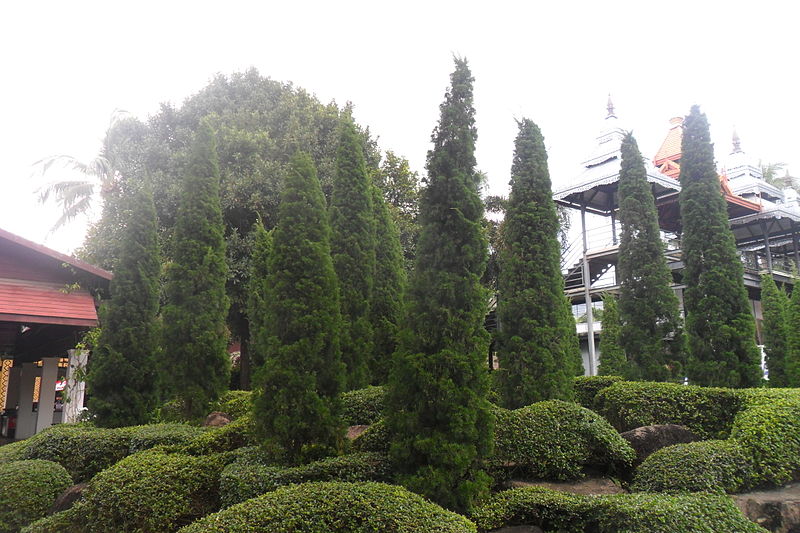
Image by and Credit to: Pescov
Spartan Juniper is a columnar juniper that has a pencil-like habit of growth which can be planted in the tiny corner of the garden.
The cultivar of juniper ‘Spartan’ is the perfect columnar tree to be growing in tight corners or to create a dense plant in an otherwise small space. The branches that grow upwards and its small size make it an elegant landscape tree. The most attractive features of the columnar trees are its upright branches and dark-green scaled leaves.
A Spartan Juniper is an evergreen tree that is a focal point in landscapes. The tiny, thin tree can grow between 15 and 20 feet (4.5 to 6 meters) tall and is just 4 to 5 feet (1.2 to 1.5 meters) across. In USDA zones 5-10 The elegant evergreen is great to be used as a foundation plant as a specimen plant or as an evergreen hedge.
- USDA Zones: 5 to 10
- Soil: Well-drained, moist soil
- Light Exposure: Full sun
- Size: 15 to 20 feet (4.5 to 6-meter) tall and 4 to 5 feet (1.2 – 1.5 meters) spread
Columnar Evergreen Italian Cypress Tree (Cupressus sempervirens)
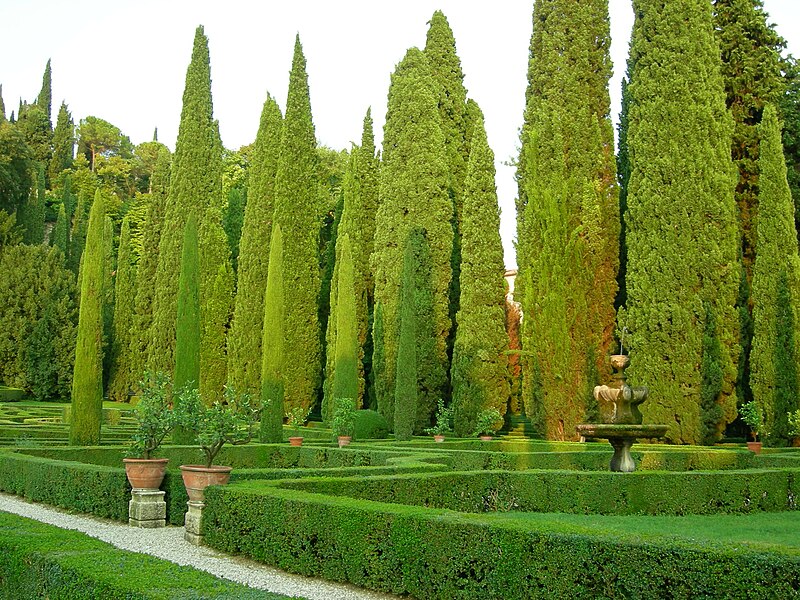
Image by and Credit to: Garden tourist
The small Italian Cypress can be extremely tall (left) However, you can also pick the smaller cultivar “Tiny Tower’ (right), that can also be cultivated in containers.
The Italian Cypress plant is an evergreen columnar tree that makes perfect for smaller gardens. It has a distinct narrow, columnar growth pattern. The ornamental evergreen exhibits fastigiate growth, drastically reducing its footprint. The slender shape of the tree looks like a pencil. The cypress tree’s distinctive features are its bluish-green, aromatic foliage as well as small oval cones and a narrow growth.
Pick the cypress “Tiny Tower cultivar” if your garden is small and requires an evergreen that is narrow to landscape. The short tree is in a natural, neat shape and is small without trimming. The slim tree can grow 40 to 70 feet (12 -23 meters) and is 10 to 20 feet (3 to 6 meters) in width.
The columnar Italian Cypress tree is suitable for small-scale gardens that are in USDA zones 7-9.
- USDA Zones: 7 to 9
- Soil: Well-drained, moist soil
- Light Exposure: Full sun
- Size: 40 – 70 feet (12 – 21 meters) tall, and 10 to 20 feet (3 to 6 m) in width
Columnar Trees for Planters
Smaller trees with fastigiate (vertical) instead of horizontal branches are great to grow in containers. The columnar plants can be used to add lush greenery to your patio or decking space. Furthermore, evergreen trees with an appearance that resembles pencils can be used as accents in entranceways.
Columnar Juniper “Gold Cone’ (Juniperus communis ‘Gold Cone’)
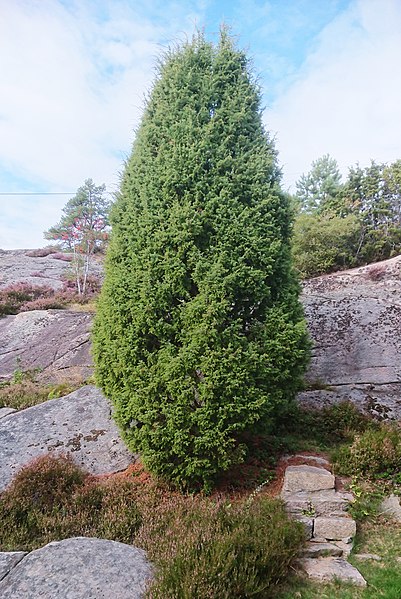
Image by and Credit to: Scienceman71
The Juniperus communis “Gold Cone” is a small, narrow evergreen tree that is planted as a container tree on patios
The Gold Cone juniper is an ideal choice when you require an upright container tree suitable for small or tight space. The most appealing feature of this cultivar is its golden yellow spring foliage that gradually turns blue-green during winter. The small columnar growth and size make it an evergreen tree ideal to grow in an outdoor planter.
Juniper Gold Cone is from 3 to 5 feet (1 – 1.5 meters) tall and can reach 2 feet (0.6 meters) broad. Its tall, narrow, columnar growth makes for an attractive exclamation point when placed in containers. The columnar tree is small enough to be able to fit in small spaces near an entranceway.
- USDA Zones: 5 to 7
- Soil: Well-drained, moist soil
- Light Exposure: Full sun
- Size: 3 to 5 feet (1 – 1.5 meters) in height, and 2 feet (0.6 meters) spread
Arborvitae ‘Emerald’ (Thuja occidentalis ‘Smaragd’)
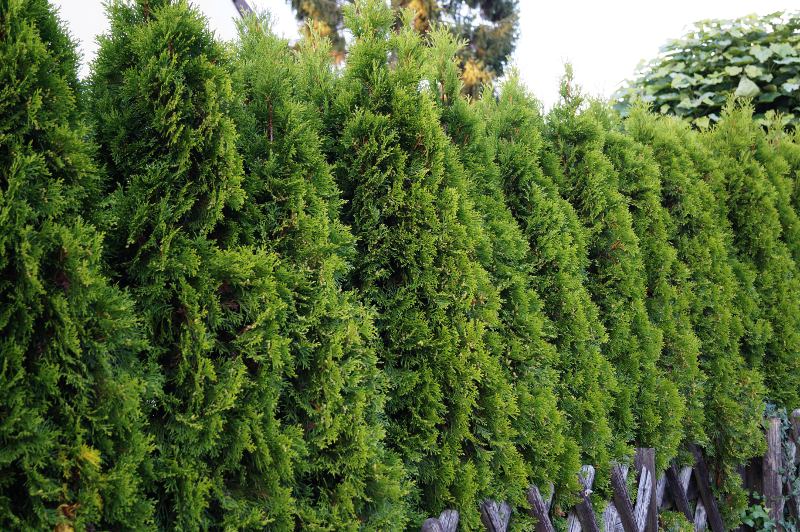
Image by and Credit to: Dieter Schlack
Thuja ’emerald Green tree (‘Smaragd’) is considered to be one of the top columnar trees to be used for living fences in smaller spaces. It can be grown in planters too.
“Smaragd” is one of the most sought-after columnar trees to be planted with a large container. The evergreen tree is characterized by its emerald-green, densely growing foliage that is with a compact growth pattern, and a pyramidal form. The Smaragd tree is ideal for planting in a tiny patio or smaller containers. It can be grown in containers and it will maintain its small dimensions.
The semi-dwarf ‘Emerald ‘ American Arborvitae can be described as a slow-growing tree with narrow habits. It is 7 to 15 feet (2 – 4.5 meters) tall and can be as tall as 3-4 feet (0.9 – 1.2 meters) in width. But, it is much smaller when it is contained in containers.
- USDA Zones: 2 to 7
- Soil: Well-drained soil
- Light Exposure: Full sun
- Size: 7 to 15 feet (2 to 4.5 meters) tall, and 3 to 4 feet (0.9 – 1.2 meters) spread
The Best Deciduous Columnar Trees for Small Gardens
Many species of deciduous trees are columnar in their growth and are suited to tight areas in compact, small gardens.
Japanese Flagpole Flowering Cherry Tree (Prunus ‘Amanogawa’)
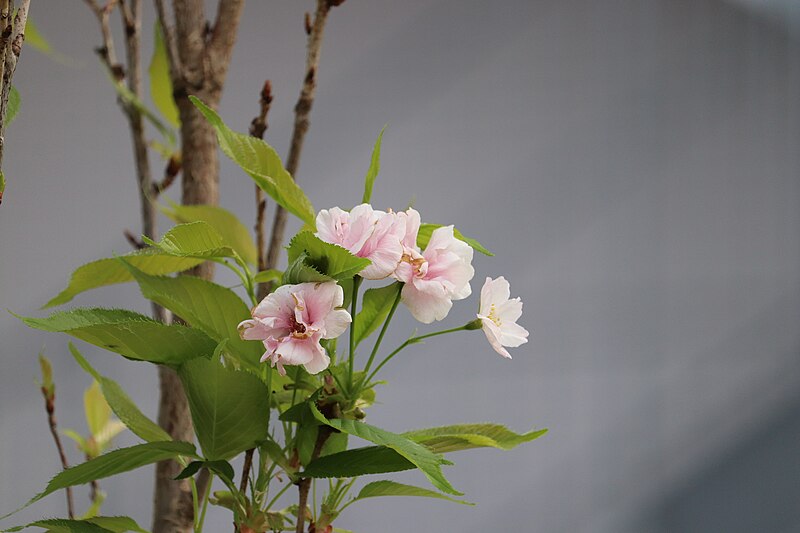
Image by and Credit to: Shigen-net
Prunus “Amanogawa” has an elongated growth pattern especially in young trees.
The slim Japanese flagpole is an upright deciduous plant that is famous for its gorgeous white-pink spring blossoms. The most notable aspects of this landscape tree are the fragrant saucer-shaped cherry blossoms, its green foliage that transforms into red and orange, and its appealing columnar form. It is a favorite tree to plant in small spaces.
It is a Japanese blooming cherry tree that is 25 feet (8 meters) tall and can spread from 4-8 feet (1 – 2 meters). It can be grown in small or large areas in USDA zones 6-8.
- USDA Zones: 6 to 8
- Soil: Well-drained, moist soil
- Light Exposure: Full sun
- Size: 25 feet (8 meters) tall 4-8 feet, and (1 to 3 meters) spread
Slender Silhouette Columnar Sweetgum Tree (Liquidambar styraciflua ‘Slender Silhouette’)
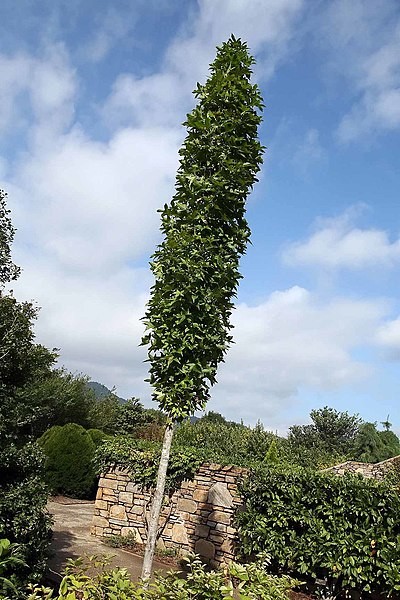
Image by and Credit to: David J. Stang
Columnar sweetgums are a tall, slim trees that can be incredible vertical accents
The sweetgum’s slender silhouette is a distinctive columnar form and deciduous leaves. The tree’s landscaping is like a corndog on a stick. The tall tree has an elongated trunk, topped with columns of uniform foliage which is shiny as well as dark and green. The leaves transform into stunning shades of yellow, red and orange in autumn.
As the slim silhouette sweetgum tree matures, it keeps its pole-like appearance which makes it a great option for an impressive border, screen or even to plant along the boundaries of your property. The sweetgum’s tall, thin tree can reach 50 feet (15 meters) high and up to 5 feet (1.5 meters) across. Columnar deciduous landscaping trees thrive in the full sunlight in USDA zones 5 to 9.
- USDA Zones: 5 to 9
- Soil: Well-drained, moist soil
- Light Exposure: Full sun
- Size: 50 ft. (15 m) tall, 5 ft. (1.5 m) spread
A Narrow Kindred Spirit Oak (Quercus x Warei “Nadler”)
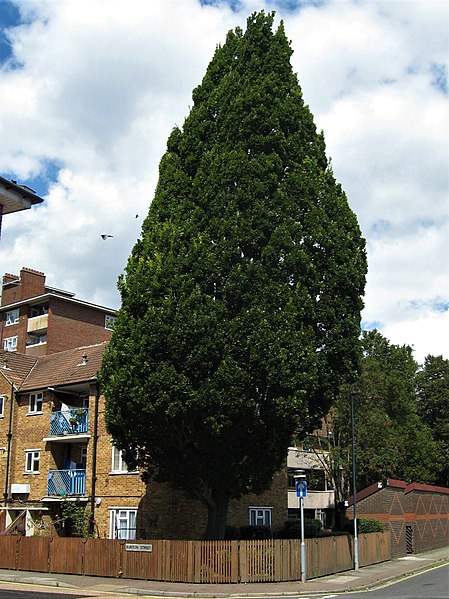
Image by and Credit to: Izigabo
This thin Kindred Spirit oak is a kind of tree that can be suited to smaller areas
The oak tree known as the ‘kindred spirit’ is an extremely fastigiate columnar oak ideal for small gardens. The attractive features of the cultivar ‘Nadler’ is its upright, slender shape as well as its dark green leaves which transform from copper-brown into red in autumn and tiny Acorns.
The columnar deciduous tree is ideal for small-sized gardens since it is 30 feet (9 meters) tall and 4 feet (1.2 meters) in width. This tree is able to be planted in a single plant as well as in rows of plants to form an evergreen hedge for privacy. The hedge is suitable for USDA zones 4-7.
- USDA Zones: 4 to 7
- Soil: Well-drained, moist soil
- Light Exposure: Full sun
- Size: 30 ft. (9 m) tall, 4 ft. (1.2 m) spread
Conclusion
In conclusion, enhancing your small garden with the elegance of columnar trees has never been simpler. This guide introduces you to the most popular slim and narrow trees, perfect for small spaces, offering both beauty and practicality. These trees, whether evergreen or deciduous, serve as focal points, design highlights, or even natural privacy fences, enhancing your garden’s aesthetic appeal.
The advantage of these slender trees lies in their vertical beauty, adding visual impact without occupying much horizontal space. With their weeping branches and conical forms, they bring shade, beauty, and protection from harsh weather elements. Moreover, their low-maintenance nature reduces the hassle of pruning, allowing you to enjoy a well-groomed garden effortlessly.
Whether you’re looking to create a green oasis in urban areas or add vertical charm to your petite garden, these columnar trees offer the perfect solution. So, explore the beauty of these trees, transform your small space into a haven, and revel in the natural elegance they bring to your garden. Happy gardening!
Featured and Pinterest images credit to: stux


